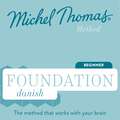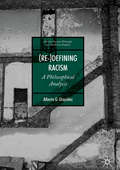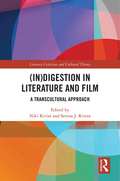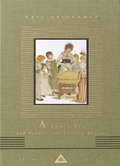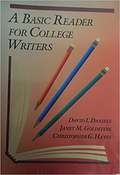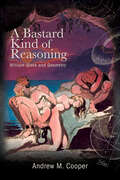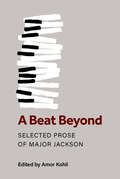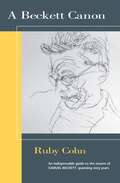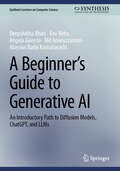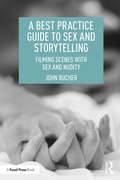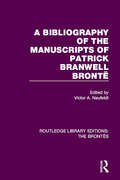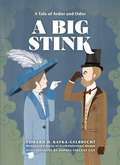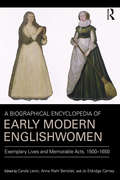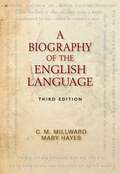- Table View
- List View
9781399815130 Foundation Danish (Michel Thomas Method) – Full course: 9781399815130 Foundation Danish (Michel Thomas Method) – Full course
by Anne Grydehoj'The thrill is that you're actually figuring it out on your own. You're engaging with another language, not just parroting it... It's an excellent way to start, and leaves the listener thinking, Hey, Ich kann do dis.' - New Yorker, David Sedaris, humorist and author, on learning German with the Michel Thomas MethodLooking for a convenient language course that fits your lifestyle and gets you speaking a new language in a matter of weeks, not years? The original no-books, no-homework, no-memorizing method is in tune with the way the brain prefers to receive, store and retrieve information. You'll stick with it because you'll love it.* Pick up Danish naturally and unforgettably without strain or stress* Learn from listening and speaking, without the pressure of writing or memorizing* Build up your Danish in manageable steps by thinking out answers for yourselfWHY IS THE METHOD SO SUCCESSFUL?'What you understand, you know; and what you know, you don't forget.' - Michel ThomasBefore there were algorithms, there was Michel Thomas. For over 50 years he worked on decoding languages by breaking them down into their most essential component parts. These 'building blocks' are introduced to the learner sequentially in such a way that you reconstruct the language for yourself - to form your own sentences, to say what you want, when you want. This unique method draws on the principles of instructional psychology and works with the way your brain prefers to receive, store and retrieve information. Knowledge is structured and organized so that you absorb the language easily and don't forget it. The method is designed to eliminate the stress which prevents you from relaxing and allowing the brain to work in the way which accepts learning in a seemingly painless, very exciting and highly motivating way.HOW DO THE COURSES WORK?'All stress inhibits true and effective learning' - Michel ThomasDuring the course, you will join Michel Thomas Method teacher Anne Grydehøj and two students in a live lesson, learning from both their successes and their mistakes to keep you motivated and involved throughout the course. You, as the learner, become the third student and participate actively in the class. Within the very first hour you will be able to construct simple phrases by listening and thinking out answers for yourself without the pressure of writing or stress of having to memorize. You will learn at your own pace, pausing and repeating where necessary, and complete the course in about 20-30 hours. By the end of the course, you will understand and have the confidence to speak basic Danish.WHAT WILL I ACTUALLY ACHIEVE?'I am the architect who builds the house. It's up to you to decorate it.' - Michel ThomasThe Michel Thomas Method will help you kick-start, continue, and flourish in your Danish language learning journey. It is not intended to get you perfectly fluent, but it will get you speaking and using Danish, with proper pronunciation, faster than any other method. It is designed to give you a strong foundation and good working knowledge of a language from which you can expand and later 'add decoration' to. It is a rapid method for learning, that requires only concentration on the part of the learner.LEARN ANYWHERE!Reclaim your pockets of free time to learn a new language! Don't be tied to chunky books or your computer, Michel Thomas Method audio courses let you learn whenever and wherever you want, in as little or as much time as you have.PLEASE NOTE: When you purchase this title, the accompanying PDF will be available in your Audible Library along with the audio.To find out more about the method, go to www.michelthomas.com(C) 1999 Thomas Keymaster Languages LLC.(P) 2024 Hodder & Stoughton, Ltd.All rights reserved.
99 More Ideas and Activities for Teaching English Learners with the SIOP Model (Siop Ser.)
by Jana Echevarria Maryellen Vogt Marilyn WashamThe SIOP ® model is proven to be one of the most effective methods of teaching our English learners. Now teaching with SIOP is even easier with the second volume of Vogt, Echevarria, and Washam's 99 MORE Ideas and Activities for Teaching English Learners with the SIOP ® Model. Offering brand new, classroom-ready activities, this indispensable resource revisits SIOP ® and shows how to use it each day in the classroom. Whether searching for activities that build vocabulary, keep students highly engaged, or make content concepts clear, these teacher-tested strategies adhere to SIOP ® principles and reinforce best practices. Chapters are organized around SIOP ®'s eight components and thirty features, so teachers learn not only what activities to try, but also why they work. With its dual focus on implementation and understanding, this must-have resource helps you create a classroom where students progress both academically and in their English language proficiency.
9th International Workshop on Spoken Dialogue System Technology (Lecture Notes in Electrical Engineering #579)
by Rafael E. Banchs Luis Fernando D’Haro Haizhou LiThis book presents the outcomes of the 9th International Workshop on Spoken Dialogue Systems (IWSDS), “Towards creating more human-like conversational agent technologies”. It compiles and provides a synopsis of current global research to push forward the state of the art in dialogue technologies, including advances in the context of the classical problems of language understanding, dialogue management and language generation, as well as cognitive topics related to the human nature of conversational phenomena, such as humor, empathy and social context understanding and awareness.
: A Philosophical Analysis (African American Philosophy and the African Diaspora)
by Alberto G. UrquidezWhat is racism? is a timely question that is hotly contested in the philosophy of race. Yet disagreement about racism’s nature does not begin in philosophy, but in the sociopolitical domain. Alberto G. Urquidez argues that philosophers of race have failed to pay sufficient attention to the practical considerations that prompt the question “What is racism?” Most theorists assume that “racism” signifies a language-independent phenomenon that needs to be “discovered” by the relevant science or “uncovered” by close scrutiny of everyday usage of this term. (Re-)Defining Racism challenges this metaphysical paradigm. Urquidez develops a Wittgenstein-inspired framework that illuminates the use of terms like “definition,” “meaning,” “explanation of meaning,” and “disagreement,” for the analysis of contested normative concepts. These elucidations reveal that providing a definition of “racism” amounts to recommending a form of moral representation—a rule for the correct use of “racism.” As definitional recommendations must be justified on pragmatic grounds, Urquidez takes as a starting point for justification the interests of racism's historical victims.
: A Transcultural Approach (Literary Criticism and Cultural Theory)
by Niki Kiviat(In)digestion in Literature and Film: A Transcultural Approach is a collection of essays spanning diverse geographic areas such as Brazil, Eastern Europe, France, Ireland, Italy, Japan, Mexico, South Korea, Taiwan and the United States. Despite this geographic variance, they all question disordered eating practices represented in literary and filmic works. The collection ultimately redefines disorder, removing the pathology and stigma assigned to acts of non-normative eating. In so doing, the essays deem taboo practices of food consumption, rejection and avoidance as expressions of resistance and defiance in the face of restrictive sociocultural, political, and economic normativities. As a result, disorder no longer equates to "out of order", implying a sense of brokenness, but is instead envisioned as an act against the dominant of order of operations. The collection therefore shifts critical focus from the eater as the embodiment of disorder to the problematic norms that defines behaviors as such.
: Digital Practices, New Forms of Participation and the Renewal of Democracy (Routledge Studies in European Communication Research and Education)
by Jeffrey Wimmer Cornelia Wallner Rainer Winter Karoline OelsnerThe practices of participation and engagement are characterised by complexities and contradictions. All celebratory examples of uses of social media, e.g. in the Arab spring, the Occupy movement or in recent LGBTQ protests, are deeply rooted in human practices. Because of this connection, every case of mediated participation should be perceived as highly contextual and cannot be attributed to one (social) specific media logic, necessitating detailed empirical studies to investigate the different contexts of political and civic engagement. In this volume, the theoretical chapters discuss analytical frameworks that can enrich our understanding of current contexts and practices of mediated participation. The empirical studies explore the implications of the new digital conditions for the ways in which digitally mediated social interactions, practices and environments shape everyday participation, engagement or protest and their subjective as well societal meaning.
: Essays on the Late Writings of Robert Duncan (Modern and Contemporary Poetry and Poetics)
by James MaynardThis collection of essays focuses on the remarkable late writings of Robert Duncan. Although praised by reviewers, Duncan's last two books of poetry have yet to receive the critical attention they merit. Written by a cast of emerging and established scholars, these essays bring together a diverse set of approaches to reading Duncan's writing.
A Apple Pie and Traditional Nursery Rhymes
by Kate GreenawayThis charming volume brings back into print some of the finest illustrated children's books from the Arts and Crafts Movement: Kate Greenaway's much-loved alphabet book, A Apple Pie, along with a selection of her illustrated nursery rhymes.Greenaway's drawings conjure up a never-never land of rural simplicity and innocence-an escape from the squalor of Victorian cities-that is as delightful now as it was when these gems of children's literature first appeared in the 1880s.
A Basic Reader for College Writers
by Janet M. Goldstein Christopher G. Hayes David I. DanielsAlthough this is designed to be a textbook, many readers will enjoy the essays, which are written by a range of authors that includes Jane Brody, John Kellmayer, Ben Fong-Torres, and Mary E. Mebane. The topics of these thirty-two essays cover throwing away food, overcoming alcoholism, learning from Japanese prisons, and baseball.
A Bastard Kind of Reasoning: William Blake and Geometry (SUNY series, Studies in the Long Nineteenth Century)
by Andrew M. CooperWhat do Einsteinian relativity, eighteenth-century field theory, Neoplatonism, and the overthrow of three-dimensional perspective have in common? The poet and artist William Blake's geometry—the conception of space-time that informs his work across media and genres. In this illuminating, inventive new study, Andrew M. Cooper reveals Blake to be the vehicle of a single imaginative vision in which art, literature, physics, and metaphysics stand united. Romantic-period physics was not, as others have assumed, materialist. Blake's cosmology forms part of his age's deep reevaluation of body and soul, of matter and Heaven, and even probes what it is to understand understanding, reason, and substance. Far from being anti-Newtonian, Blake was prophetically post-Newtonian. His poetry and art realized the revolutionary potential of Enlightened natural philosophy even as that philosophy still needed an Einstein for its physics to snap fully into focus. Blake's mythmaking exploits the imaginative reach of formal abstractions to generate a model of how sensation imparts physical extension to the world. More striking still, Cooper shows how Blake's art of vision leads us today to visualize four-dimensional concepts of space, time, and Man for ourselves.
A Beat Beyond: Selected Prose of Major Jackson (Poets On Poetry)
by Major JacksonIn this collection of essays, interviews, and notes, Major Jackson revels in the work of poetry not only to limn and assess the intellectual and spiritual dimensions of poets, but to amplify the controversies and inner conflicts that define our age: political unrest, climate crises, the fallout from bewildering traumas, and the social function of the art of poetry itself. Accessible and critically minded, Jackson returns to the poem as an unparalleled source of linguistic pleasure that structures a multilayered “lyric self.” In his interviews, Jackson illustrates poetry’s distinct ability to mediate the inexplicable while foregrounding the possibilities of human song. Collected over several decades, these essays find Jackson praising mythmaking in Frank Bidart and Ai’s poetry, expressing bafflement at the silence of white-identified poets in the cause of social and racial justice, unearthing the politics behind Gwendolyn Brooks’s Pulitzer Prize, and marveling at the “hallucinatory speed of thought” in a diverse range of poets including Mei-mei Berssenbrugge, Brenda Hillman, Afaa Michael Weaver, Forrest Gander, and Terrance Hayes. This collection passionately surveys the radical shifts of the art and notes poetry as a necessity for a modern sensibility.
A Beckett Canon
by Ruby CohnSamuel Beckett is unique in literature. Born and educated in Ireland, he lived most of his life in Paris. His literary output was rendered in either English or French, and he often translated one to the other, but there is disagreement about the contents of his bilingual corpus. A Beckett Canon by renowned theater scholar Ruby Cohn offers an invaluable guide to the entire corpus, commenting on Beckett's work in its original language. Beginning in 1929 with Beckett's earliest work, the book examines the variety of genres in which he worked: poems, short stories, novels, plays, radio pieces, teleplays, reviews, and criticism. Cohn grapples with the difficulties in Beckett's work, including the opaque erudition of the early English verse and fiction, and the searching depths and syntactical ellipsis of the late works. Specialist and nonspecialist readers will find A Beckett Canon valuable for its remarkable inclusiveness. Cohn has examined the holdings of all of the major Beckett depositories, and is thus able to highlight neglected manuscripts and correct occasional errors in their listings. Intended as a resource to accompany the reading of Beckett's writing--in English or French, published or unpublished, in part or as a whole--the book offers context, information, and interpretation of the work of one of the last century's most important writers.
A Bees' Life (Time For Kids®: Informational Text)
by Dona Herweck RiceHow does a small egg become a buzzing bee? With a graph of a bee's life cycle, vivid photos, explanatory vocabulary, and informational text, readers are sure to be captivated! About Shell Education Rachelle Cracchiolo started the company with a friend and fellow teacher. Both were eager to share their ideas and passion for education with other classroom leaders. What began as a hobby, selling lesson plans to local stores, became a part-time job after a full day of teaching, and eventually blossomed into Teacher Created Materials. The story continued in 2004 with the launch of Shell Education and the introduction of professional resources and classroom application books designed to support Teacher Created Materials curriculum resources. Today, Teacher Created Materials and Shell Education are two of the most recognized names in educational publishing around the world.
A Beginner’s Guide to Generative AI: An Introductory Path to Diffusion Models, ChatGPT, and LLMs (Synthesis Lectures on Computer Science)
by Deepshikha Bhati Fnu Neha Angela Guercio Md Amiruzzaman Aloysius Bathi KasturiarachiThis book is the essential guide for anyone curious about AI’s creative power. In the rapidly evolving landscape of artificial intelligence, generative AI stands out as one of the most transformative technologies of our time. Designed for beginners and requiring no prior knowledge of AI, this book breaks down the fundamentals of generative AI, from text and image generation to the workings of models like ChatGPT and Google Bard. The authors provide step-by-step coverage of the essential concepts and techniques that power generative AI. From the basics of how machines learn to generate text and images, to the intricate workings of models like Transformers, ChatGPT, and Google Bard, readers will gain a solid foundation in AI's most cutting-edge tools. Rather than focusing on a single method, the authors introduce a spectrum of generative modeling techniques, including diffusion models, variational autoencoders, and transformers. This comprehensive exposure ensures readers will be well-prepared to understand and adapt to the rapidly evolving AI landscape. In addition, real-world applications of generative AI across various industries are explored including healthcare innovations, business analytics, and legal technology, and the authors provide practical insights and examples that show how generative AI is revolutionizing these fields.
A Bergsonian Approach to Translation and Time: Toward Spiritual Translation Studies (ISSN)
by Salah BasalamahThis innovative book offers a systematic conceptual exploration of translation through the lens of time, challenging the traditional notion of translation as mere linguistic transfer and advancing a new research agenda within the philosophy of translation.The volume sets the stage by establishing an overarching framework that positions the philosophy of translation as a distinct subdiscipline within translation studies. It then reviews existing scholarship on translation in light of Henri Bergson's philosophy of time, proposing an expanded conceptualization of translation. Using this foundation, Basalamah explores a variety of topics at the intersection of translation and time from transdisciplinary perspectives, including epistemology, consciousness, mediations through image and art, the mind/body problem, time in phenomenology, and ethical and religious considerations.As a pioneering work on the temporal characteristic of translation, this book will be of interest to students and scholars in translation studies, especially those focused on its philosophical treatment.
A Best Practice Guide to Sex and Storytelling: Filming Scenes with Sex and Nudity
by John BucherA great deal of storytelling in film and television involves narratives that include sexual situations and nudity. The increased amount of on-line and streaming content outlets has in turn increased the number of narratives that involve these once-taboo subjects. Often, even though directors and producers desire to handle such issues with professionalism, sets become awkward when producing these scenes. A Best Practice Guide to Sex and Storytelling serves as a helpful tool for guiding creators through these waters. Even as the practice has become more common, the environments in which individuals on both sides of the camera work to create sensitive content have not become any more comfortable. To date, there have been no industry guides and little practical instruction on how to approach such important yet delicate scenes. Sex and Storytelling offers theoretical and practical approaches to creating the most effective content, while honoring the dignity and humanity of everyone involved on-set when sexuality and nudity is a part of the story being told. Drawing on John Bucher’s professional experience in both high- and low-budget environments and including interviews with players from both sides of the camera, this book provides an essential guide to handling sex and nudity for film and television in a professional manner.
A Bibliographical Catalogue of Italian Books Printed in England 1558–1603 (Anglo-Italian Renaissance Studies)
by Soko TomitaThrough entries on 291 Italian books (451 editions) published in England during the reign of Queen Elizabeth I, covering the years 1558-1603, this catalogue represents a summary of current research and knowledge of diffusion of Italian culture on English literature in this period. It also provides a foundation for new work on Anglo-Italian relations in Elizabethan England. Mary Augusta Scott's 1916 Elizabethan Translations from the Italian forms the basis for the catalogue; Soko Tomita adds 59 new books and eliminates 23 of Scott's original entries. The information here is presented in a user-friendly and uncluttered manner, guided by Philip Gaskell's principles of bibliographical description; the volume includes bibliographical descriptions, tables, graphs, images, and two indices (general and title). In an attempt to restore each book to its original status, each entry is concerned not only with the physical book, but with the human elements guiding it through production: the relationship with the author, editor, translator, publisher, book-seller, and patron are all recounted as important players in the exploration of cultural significance. Renaissance Anglo-Italian relations were marked by both patriotism and xenophobia; this catalogue provides reliable and comprehensive information about books and publication as well as concrete evidence of what elements of Italian culture the English responded to and how Italian culture was acclimatized into Elizabethan England.
A Bibliography of Robertson Davies
by Judith Skelton Grant Carl SpadoniRobertson Davies (1913-1995), one of Canada's most distinguished authors of the twentieth century, was known for his work as a novelist, playwright, critic, journalist, and professor. This descriptive bibliography is dedicated to his writing career, covering all publications from his first venture into print at the age of nine to works published posthumously to 2011. Entries include each of Davies' signed publications and those pseudonymous or anonymous writings he acknowledged having written. Included are his plays, novels, journalism, academic writing, translations, interviews, speeches, lectures, unsigned articles and editorials, films, audio recordings, and multimedia editions. Also listed is a generous sampling of unsigned articles and editorials.Using Davies' archives and the archives of other authors, organizations, and publishers, Carl Spadoni and Judith Skelton Grant present A Bibliography of Robertson Davies to serve the research demands of Canadian literature and book history scholars.
A Bibliography of the Manuscripts of Patrick Branwell Brontë (Routledge Library Editions: The Brontës)
by Victor A. NeufeldtThis bibliography, first published in 1993, attempts to provide a complete and accurate description of the manuscripts of Patrick Branwell Brontë, excluding his letters. Its aim is not only to correct previous errors and update and extend earlier lists, but also to reconstruct as far as possible dismembered and scattered manuscripts. This book will be of interest to students of English Literature.
A Big Stink: A Tale of Ardor and Odor
by Edward H. Kafka-GelbrechtA delightfully illustrated story about passing gas and passing the buck, by a renowned scholar of gastrointestinal humor who has seen and smelled it all.The marriage of flatulence and wordplay is a potent source of pleasure as old as language itself. So says Edward H. Kafka-Gelbrecht, who has spent a lifetime studying the art of the unclaimed fart, from the courtroom to the convent. Now, in this illustrated tour de force, he airs a more personal story about a quiet elevator ride that is shattered by an ignoble gas. Starting with the classic &“He who smelt it, dealt it&” and the indignant riposte &“She who denied it, supplied it,&” the repartee heats up as the elevator rises. Can a reek that drives people apart instead bring two hearts together? A Big Stink&’s beguiling blend of highbrow and lowbrow humor will delight oversharing families and word lovers alike. Illustrator Sophia Vincent Guy ramps up the fun with elegantly detailed illustrations sprinkled with Easter eggs. Sure to reduce even the most solemn adults to irrepressible giggles, A Big Stink is a ripping good read and a breath of foul air.
A Biocultural Approach to Literary Theory and Interpretation
by Nancy EasterlinCombining cognitive and evolutionary research with traditional humanist methods, Nancy Easterlin demonstrates how a biocultural perspective in theory and criticism opens up new possibilities for literary interpretation.Easterlin maintains that the practice of literary interpretation is still of central intellectual and social value. Taking an open yet judicious approach, she argues, however, that literary interpretation stands to gain dramatically from a fair-minded and creative application of cognitive and evolutionary research. This work does just that, expounding a biocultural method that charts a middle course between overly reductive approaches to literature and traditionalists who see the sciences as a threat to the humanities.Easterlin develops her biocultural method by comparing it to four major subfields within literary studies: new historicism, ecocriticism, cognitive approaches, and evolutionary approaches. After a thorough review of each subfield, she reconsiders them in light of relevant research in cognitive and evolutionary psychology and provides a textual analysis of literary works from the romantic era to the present, including William Wordsworth’s "Simon Lee" and the Lucy poems, Mary Robinson’s "Old Barnard," Samuel Taylor Coleridge’s "Dejection: An Ode," D. H. Lawrence’s The Fox, Jean Rhys’s Wide Sargasso Sea, and Raymond Carver’s "I Could See the Smallest Things."A Biocultural Approach to Literary Theory and Interpretation offers a fresh and reasoned approach to literary studies that at once preserves the central importance that interpretation plays in the humanities and embraces the exciting developments of the cognitive sciences.
A Biographical Encyclopedia of Early Modern Englishwomen: Exemplary Lives and Memorable Acts, 1500-1650
by Carole Levin Jo Eldridge Carney Anna Riehl BertoletFrom the exemplary to the notorious to the obscure, this comprehensive and innovative encyclopedia showcases the worthy women of early modern England. Poets, princesses, or pirates, the women of power and agency found in these pages are indeed worth knowing, and this volume will introduce many female figures to even the most established scholars in early modern studies. Rather than using the conventional alphabetical format of the standard biographical encyclopedia, this volume is divided into categories of women. Since many women will fit in more than one category, each woman is placed in the category that best exemplifies her life, and is cross referenced in other appropriate sections. This structure makes the book an interesting read for seasoned scholars of early modern women, while students need not already be familiar with these subjects in order to benefit from the text. Another unusual feature of this reference work is that each entry begins with some incident from the woman’s life that is particularly exciting or significant. Some entries are very brief while others are extensive. Each includes a source listing. The book is well illustrated and liberally sprinkled with quotations of the time either by or about the women in the text.
A Biography of the English Language
by Mary Hayes C. M. MillwardThe third edition of A BIOGRAPHY OF THE ENGLISH LANGUAGE continues to examine the structure of English, from its Indo-European pre-history, through the invasions that shaped Old and Middle English, through its speakers' conscious efforts to police it in the Early Modern period, through its present-day transformations manifest in urban slang and text-messaging. <p><p>The textbook explores three important issues: how languages and language change are systematic; how the inner history of a language is profoundly affected by its outer history of political and cultural events; and how the English of the past has everywhere left its traces on present-day English. By uncovering the language's past, one can better use it to communicate as well as speculate about its future use in ever-changing globalized media.
A Biome of the World: The Taiga
by Carol TalleyThe final installment of the Reading Street curriculum series, Reading Street: Grade 6, comes complete with everything you'll need to create English and Language Arts lessons for your child. This system includes reading selections designed to help your child hone his or her skills, a Teacher Resource DVD to make your task of developing lessons easier, and a packet of curriculum materials. Reading Street: Grade 6 is a comprehensive system designed to enhance your child's skills in reading, writing and language. Each assignment in Reading Street helps your child progress toward that goal. While such a dynamic curriculum might sound challenging for you as a parent and educator to use, you can rest assured that the materials will guide you through 12 weeks of English and Language Arts lesson planning with ease. If you prefer a structured homeschooling program format, Reading Street (in all of its Grade level structures) is the right fit for you and your child. Grade 6 comes with two volumes of six units. By the time you complete Grade 6, your child will be able to: Read through a variety of complex literature, including biographies and fictional stories. Discover additional reading material based on personal taste. Relate individual chapters or concepts to the book as a whole. Write complete stories using proper grammar, punctuation and word choice. Compose a written argument using appropriate sources. Examine and edit his or her own writing, as well as the writing of others. Present an oral presentation based on the lessons. Unlike other curricula, Reading Street imparts a love of reading upon your child. From Grade 1 through Grade 6, your child will learn not only the skills he or she needs to advance his or her education, but become a lifelong student and reader. For more information about the specific materials included in the Reading Street: Grade 6 curriculum for homeschooling, visit the Features and Benefits page.
